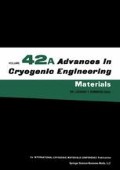Abstract
The 45-T Hybrid Magnet will use NbTi and Nb3Sn Cable-In-Conduit Conductors (CICC) operating at 10 kA to produce a field of 14-T on axis in a 710-mm diameter magnet bore. A candidate Nb3Sn wire has been evaluated and selected for this application. However, the copper stabilizer of some wires has been shown to be susceptible to contamination, from unknown sources, which results in low Residual Resistivity Ratios (RRR). Here we report a characterization of wire given abbreviated heat treatment schedules designed to improve the RRR. It is shown that the RRR is readily improved by modifying the heat treatment schedule while critical current density remains above specified minimums. RRR and critical current density as a function of heat treatment and critical current density as a function of axial strain are reported.
Access this chapter
Tax calculation will be finalised at checkout
Purchases are for personal use only
Preview
Unable to display preview. Download preview PDF.
References
L. T. Summers, J. C. McKinnell, S. L. Bray, and J. W. Ekin, Characterization of multifilamentary Nb3Sn superconducting wires for use in the 45-T Hybrid Magnet, IEEE Trans. Appl. Superconductivity, 5:1764 (1995).
J. C. McKinnell, P. M. O’larey, P. D. Jablonski, and M. B. Siddall, Tantalum-niobium alloy diffusion barriers for Nb3Sn wires in fusion applications, presented at International Cryogenic Materials Conference, Columbus, OH, 1995.
L. T. Summers, M. W. Guinan, J. R. Miller, and P. A. Hahn, A model for the prediction of Nb3Sn critical current as a function of field, temperature, strain and radiation damage., IEEE Trans. Mag., 27: 2041 (1991).
J. W. Ekin, Strain scaling law for flux pinning in practical superconductors. Part 1: Basic relationship and application to Nb3Sn conductors, Cryogenics, 20:611 (1980).
J. Kübier, H.-J. Schindler, and W. J. Muster, Influence of aging on the fracture toughness of cryogenic austenitic materials, Evaluated by a Simple Test Method, Adv. Cryo. Eng., 38:191 (1992).
Author information
Authors and Affiliations
Editor information
Editors and Affiliations
Rights and permissions
Copyright information
© 1996 Springer Science+Business Media New York
About this chapter
Cite this chapter
Summers, L.T., McKinnell, J.C., Walsh, R.P., Miller, J.R. (1996). Further Studies of Nb3Sn Wire for the 45-T Hybrid Magnet. In: Summers, L.T. (eds) Advances in Cryogenic Engineering Materials . Advances in Cryogenic Engineering Materials , vol 42. Springer, Boston, MA. https://doi.org/10.1007/978-1-4757-9059-7_181
Download citation
DOI: https://doi.org/10.1007/978-1-4757-9059-7_181
Publisher Name: Springer, Boston, MA
Print ISBN: 978-1-4757-9061-0
Online ISBN: 978-1-4757-9059-7
eBook Packages: Springer Book Archive

